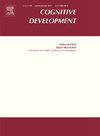幽默对婴儿社会学习的影响:来自社会凝视、心率变异性和笑声的见解
IF 1.8
3区 心理学
Q3 PSYCHOLOGY, DEVELOPMENTAL
引用次数: 0
摘要
幽默是人类文化的一个普遍方面,具有社会和认知功能。本研究从生理、行为和情绪反应三个方面探讨幽默对婴儿学习的影响。在之前的研究基础上,我们研究了三个问题:(1)幽默是否会影响婴儿在社会学习任务中的行为,比如看、笑和微笑?(2)幽默是否能促进学习,这种影响是否与年龄有关?(3)由心率变异性(HRV)测量的觉醒能否解释幽默与学习之间的关系?我们测试了88名年龄在14-22 个月的婴儿,让他们观看幽默或中性的工具使用任务演示。我们在示范后评估婴儿的表现,并对社会注视和情绪反应进行编码。我们还通过连接的腕带分析了生理唤醒指标,即心率变异性(HRV)。我们的分析显示,与那些处于中立状态的婴儿相比,接触幽默表演的婴儿表现出更强的学习能力,这与他们是否笑无关。这表明笑并不能调节幽默对学习的影响。此外,幽默组的婴儿会更多地看向实验者,这可能表明他们的参与度或注意力过程有所增加。最后,我们的HRV分析显示,成功完成任务的婴儿比没有完成任务的婴儿表现出更高的HRV。本研究首次探讨了幽默对婴儿学习的影响机制,强调了其复杂性和对认知、行为和生理因素的多维综合研究的必要性。本文章由计算机程序翻译,如有差异,请以英文原文为准。
The impact of humor on infant social learning: Insights from social gaze, heart rate variability, and laughter
Humor is a universal aspect of human culture, serving both social and cognitive functions. This study investigates humor's influence on infant learning, focusing on physiological, behavioral, and emotional responses. Building on previous research, we examined three questions: (1) Does humor affect infants' behaviors during a social learning task, such as looking, laughing, and smiling? (2) Does humor enhance learning, and is this effect age-dependent? (3) Can arousal, measured by heart rate variability (HRV), explain the relationship between humor and learning? We tested 88 infants aged 14–22 months, exposing them to either a humorous or neutral demonstration of a tool-use task. We assessed infants’ performance after demonstration and coded social gazes and emotional reactions. We also analyzed physiological arousal indicators, namely heart rate variability (HRV), through a connected wristband. Our analyses revealed that infants exposed to humorous demonstrations showed enhanced learning compared to those in the neutral condition, independently of whether they laughed or not. This suggests that laughing does not mediate the effect of humor on learning. Additionally, infants in the humorous condition looked more at the experimenter, which could indicate increased engagement or attentional processes. Finally, our HRV analyses revealed that infants who succeeded in the task exhibited higher HRV than those who did not. This study is the first to explore the mechanisms underlying humor’s effect on infant learning, emphasizing its complexity and the need for a multidimensional approach integrating cognitive, behavioral, and physiological factors.
求助全文
通过发布文献求助,成功后即可免费获取论文全文。
去求助
来源期刊

Cognitive Development
Multiple-
CiteScore
3.20
自引率
5.60%
发文量
114
期刊介绍:
Cognitive Development contains the very best empirical and theoretical work on the development of perception, memory, language, concepts, thinking, problem solving, metacognition, and social cognition. Criteria for acceptance of articles will be: significance of the work to issues of current interest, substance of the argument, and clarity of expression. For purposes of publication in Cognitive Development, moral and social development will be considered part of cognitive development when they are related to the development of knowledge or thought processes.
 求助内容:
求助内容: 应助结果提醒方式:
应助结果提醒方式:


